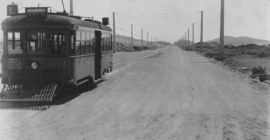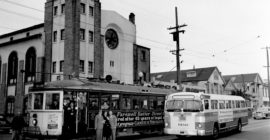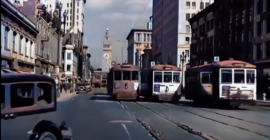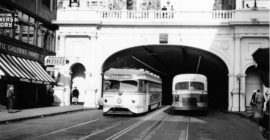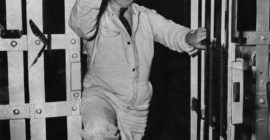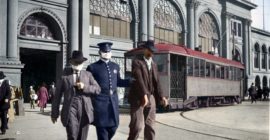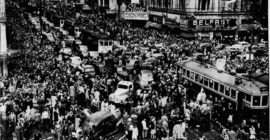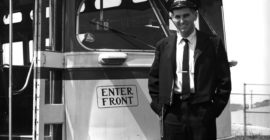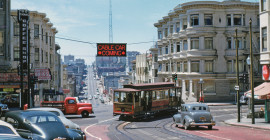When street railway companies laid tracks in San Francisco streets, they were responsible for maintaining the area around the tracks. That’s part of the reason it was customary to lay a row of basalt pieces right next to the outer rails. The dense, heavy, gray stone is correctly called Belgian block or sett though often mistakenly called cobblestone. (Cobbles are more egg shaped.)
History Features
Streetcars to buses
See gallery at end of story
Market Street 1932: Wowza!
Market Street, in color, in 1932, when essentially all film was black and white. And not just static, like the photo above, but in full and glorious rumble. Click the video below and prepare to get lost in the past for the next four minutes.
What might have been
Editor’s note: A version of this story, by the late Cameron Beach and MSR President Rick Laubscher, appeared in a 2003 issue of Inside Track, our member magazine with exclusive stories and inside information about Muni’s historic streetcars and cable cars. Click here to become a member and receive it.
Ding Dong Daddy: The real story
By Grant Ute, Friends of SF Railway Archive
Two transit pandemics
The Bay Area’s transit agencies are slowly restoring service after deep cutbacks triggered by the shelter-in-place orders imposed in mid-March. Muni, for example, dropped from about 80 lines to just seven, with all rail service, including the historic streetcars and cable cars, suspended. San Franciscans have been ordered to wear masks whenever they’re in public places. (We have history-inspired masks at our store.)
Jubilation — and riots — on Market Street 75 years ago
When President Harry Truman announced the Japanese surrender on August 14, 1945, ending World War II, celebrations erupted around the world. As the primary port of embarkation for US troops headed to the Pacific, San Francisco’s revelry was especially intense.
Pedal to the metal: “Finding room to run”
We all know that old saying, “They don’t make them like THAT anymore”. With the late Art Curtis, that’s the truth. In his 37-year career with Muni, Art solved all kinds of operational problems as Chief Inspector, but as a “young buck” (his term) operator, he created his share of mischief, too. We’ll be sharing a couple of stories here told by Art himself. This one comes from a 2009 issue of our member magazine, Inside Track. (Join us to get this quarterly magazine with its stories of San Francisco transit history as an exclusive member benefit.)
When politics & dirty tricks savaged our cable cars
In the wee hours of Sunday morning, May 16, 1954, several hundred San Franciscans gathered at California and Hyde Streets. They weren’t late-night shopping at Trader Joe’s, but rather were protesting what was then happening to the previous occupants of that property–cable cars.
“My City, My Game”
“This is my city and my game…You birds’ll be in New York or Constantinople or some place else. I’m in business here.” – Sam Spade
Archive: All Posts
